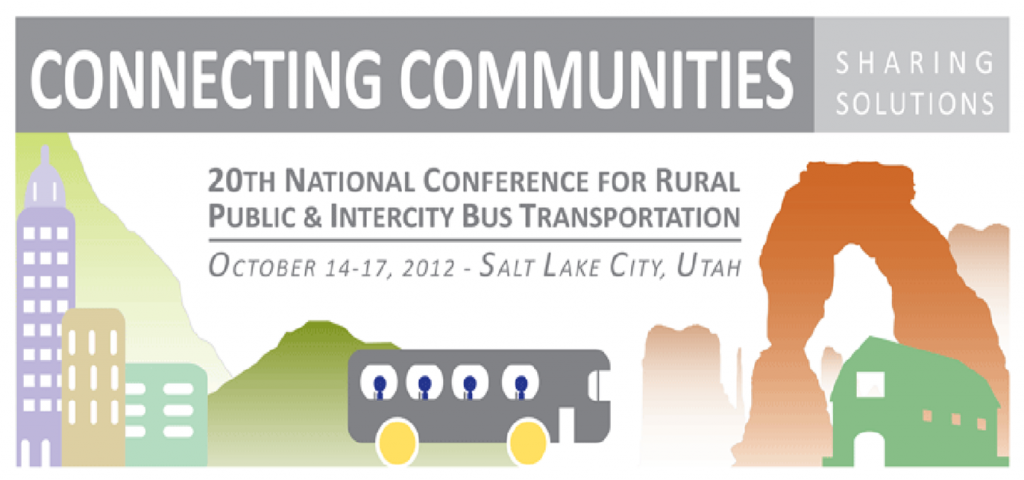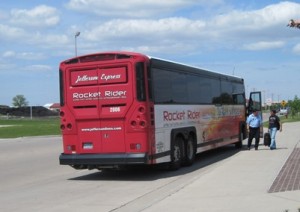Transit Policy Resources Posted to SURTC Website
New resources have been added to the SURTC website to assist transit agencies in developing policies and procedures. SURTC collected a number of sample policies, procedures, and report forms from different organizations and posted them online so they can be viewed, downloaded, and adopted by transit agencies.
Included are good examples of advisory board by-laws, driver handbooks, no-show policies, riders’ guides, vehicle maintenance programs, accident report forms, guidelines on local planning and coordination, and many others. As with all samples, these should be reviewed by your board of directors and legal counsel if you wish to adopt them.
These transit policy examples are found in the Other Resources section of the SURTC website.
SURTC Partnering with National Center on Senior Transportation
SURTC is working with the National Center on Senior Transportation (NCST) to develop a plan for conducting technical assistance and training needs assessments.
NCST has been administered by Easter Seals, Inc. and the National Association of Area Agencies on Aging (n4a) since its inception, and these partners were once again selected in 2012 by the Federal Transit Administration to administer the center.
Easter Seals, Inc. and n4a identified the development of a plan for conducting technical assistance and training needs assessments as one of NCST’s milestones.
Ph.D. student Elvis Ndembe and Dr. Jill Hough began work on this project December 1, 2012. Ndembe and Hough are looking at past successful technical assistance mechanisms NCST has utilized and will develop survey instruments, conduct focus groups, and evaluate other appropriate data sources to help with the new assessment. The assessment should be completed by May 2013.
Research Report – Travel Behavior and Mobility of Transportation-Disadvantaged Populations: Evidence from the National Household Travel Survey
A new report published by SURTC examines travel behavior and mobility of older adults, people with disabilities, individuals from low-income households, and rural residents by analyzing data from the National Household Travel Survey (NHTS). NHTS is a nation-wide survey last conducted in 2009.
The study, conducted by researcher Jeremy Mattson, highlights data on driving, trip frequency, staying in the same place all day or week, miles driven per year, mode choice, use of public transportation, trip purpose, trip distance, and issues and concerns regarding transportation. Changes over the last decade were also examined to identify trends in travel behavior.
Findings show how use of transit increases the number of trips taken and provides rides to individuals who would otherwise not make the trip. The study also shows the differences in mobility between different population groups. Half of those 85 or older were found to have a disability or medical condition affecting their ability to travel, and for many of them, it results in reduced day-to-day travel. A strong desire to get out more often was found by those not making a trip within the last week, which shows the importance of mobility on quality of life. People with disabilities or medical conditions were shown to make significantly fewer trips than others, while expressing a desire to get out more often.
Trends from 2001 to 2009 show increased use of transit. Older women are driving more and making more trips than they were a decade ago, slowly closing the gap between older men and women. These trends may continue as the active baby boom generation retires and expects to maintain their mobility.
For more information about the study, contact Jeremy Mattson at jeremy.w.mattson@ndsu.edu. The full report can be downloaded at the following link: Travel Behavior and Mobility of Transportation-Disadvantaged Populations: Evidence from the National Household Travel Survey.
Mattson had previously presented findings from this study at the International Conference on Aging, Mobility and Quality of Life. That presentation is also available on the SURTC website.
Categories: Publications, Research
FTA Online Dialogue on Transit Asset Management
The Federal Transit Administration (FTA) is inviting public transportation stakeholders to participate in a national online dialogue on transit asset management (TAM), from December 12, 2012 to January 4, 2013. This dialogue will provide participants the opportunity to discuss and provide suggestions on some of the key questions surrounding TAM. The dialogue is free and open to the public. States, MPOs, local governments, transit agencies, and transit advocacy groups are especially encouraged to participate.
For more details, download the informational flyer here (pdf) or go to the following link to register and participate: National Online Dialogue on Transit Asset Management
Journal of Public Transportation Special Edition: Rural and Intercity Bus
SURTC director Jill Hough was guest editor of the latest issue of the Journal of Public Transportation – a special edition focusing on rural and intercity bus. The Journal of Public Transportation is published by the National Center for Transit Research at the University of South Florida. This issue commemorated the 20th National Conference for Rural Public & Intercity Bus Transportation. It also celebrated the partnership between the University of South Florida and North Dakota State University as one of the University Transportation Centers focusing on public transportation in the United States. Included in this edition is an article by SURTC researcher Jeremy Mattson on the use of alternative fuels and hybrid vehicles by small urban and rural transit systems. The articles in this special edition can be viewed at the following link: Journal of Public Transportation – Vol. 15, No. 3 (2012)
Staff Presentations from Rural & Intercity Bus Conference Online
The following presentations given by SURTC researchers Jeremy Mattson and Del Peterson at the 20th National Conference for Rural Public & Intercity Bus Transportation are available to view or download on the SURTC website:
- Use of Alternative Fuels and Hybrid Vehicles by Small Urban and Rural Transit Systems
- Transit, Technology, & Public Participation
- Effortless Passenger Identification System
These and other presentations are available in the Staff Presentation section of the SURTC website.
Updated Training Information Posted
An updated list and description of training courses being offered by SURTC has been posted online. SURTC has been developing new training courses and broadening the types of training offered. Among the recently developed classes include "Environmental Justice and Public Participation" and "Safety, Security, and Emergency Management." Both of these classes will be available for booking in early 2013. "Capital Asset Management" is another new class that is now available. Visit the Training on Demand section of the SURTC website to view the list of training courses currently being offered.
SURTC develops and provides training for transit operators, transit associations, and state Departments of Transportation as needs are identified. If you would like to host a training session, please email ndsu.ugpti@ndsu.edu.
SURTC Fall 2012 Newsletter
The Fall 2012 issue of the Transit Lane Brief has been published and is available online. This issue has articles on three new research projects that are underway, two reports that were recently published, and SURTC's numerous ongoing training activities. The current and previous issues can be downloaded from the SURTC website.
SURTC to Participate in National Conference on Rural Public and Intercity Bus Transportation
SURTC staff will be heavily involved in the 20th National Conference on Rural Public and Intercity Bus Transportation, held October 14-17 in Salt Lake City, UT. This conference, held every two years, focuses on the latest in best practice and current research in rural public and intercity bus transportation.
Director Jill Hough is serving on the conference planning committee and will moderate and participate in a session on transit workforce development. Keven Anderson, training coordinator, will also participate in that session. Hough’s presentation is titled “Mentoring the Next Generation of Public Transit Workers” and Anderson’s is “Succession Planning and Mentorship.”
Carol Wright, associate director of training and outreach, will present “Addressing Language Barriers for Passengers, Drivers, and Dispatchers” in a session on effective communications for rural transportation, and she will present “Development and Assessment of Agency Policies and Practices for Civil Rights” in a session on civil rights. Wright and Anderson will also team to make a presentation on tribal transit.
Researchers Jeremy Mattson and Del Peterson will be participating in a session on how technology is improving operations. Mattson will present results from a study on the use of alternative fuels and hybrid vehicles by small urban and rural transit systems, and Peterson will present research on the use of effortless passenger identification systems.
Peterson and Mattson will also give a presentation, titled “Transit, Technology & Public Participation,” that will present findings from research on the use of new technologies to improve public participation in transit planning. This session focuses on how technology is facilitating dialogue between providers and the community.
Visit the conference website for more information.

New Study to Research Demand for Intercity Transit Services and Optimal Service Levels
SURTC researcher Jeremy Mattson is launching a new study to estimate demand for intercity transit services in rural areas and determine optimal service levels.
The study will examine how gas prices, fare levels, travel speed, and service frequency influence demand for intercity bus and rail and how demand differs based on individual characteristics such as age and income. The study will also estimate how far travelers are willing to drive to a bus or rail station to use those services. The cost and time associated with traveling to and from transit stations will be factored into the study.
 Results from the study of mode choice will be used to estimate intercity bus and rail demand along different corridors. The research will be conducted in North Dakota, but the methodologies developed could be applied to other areas. Different scenarios with different travel times, service frequencies, stop locations, fare levels, and gas prices will be considered, as will the impacts of changing demographics.
Results from the study of mode choice will be used to estimate intercity bus and rail demand along different corridors. The research will be conducted in North Dakota, but the methodologies developed could be applied to other areas. Different scenarios with different travel times, service frequencies, stop locations, fare levels, and gas prices will be considered, as will the impacts of changing demographics.
Optimal service levels will be identified based on cost of providing service, costs associated with automobile travel, ridership levels, number of new trips that are created, and costs associated with impacts on the environment and traveler safety.
For more details, contact Jeremy Mattson at jeremy.w.mattson@ndsu.edu.